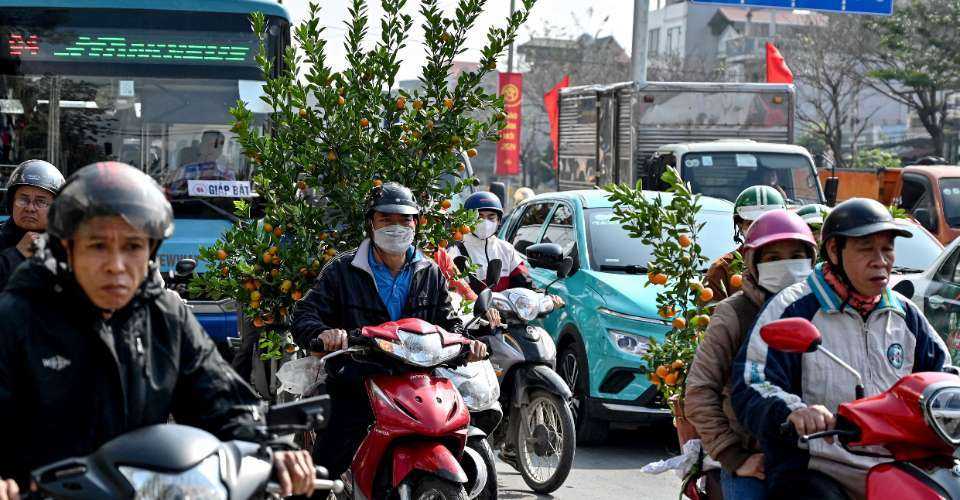
Vietnamese people transport kumquat trees on their motorcycles in Hanoi as they prepare to celebrate their traditional Tet or Lunar New Year of the Dragon on Feb. 10 this year. (Photo: AFP)
The Church's principles are rooted in thousands of years of wisdom, drawing from a deep well of human experience and understanding. This longevity is a testament to the enduring value of its teachings. For instance, the emphasis on strong family units has been a cornerstone of societal stability throughout history.
The Church's promotion of compassion, community support, and moral integrity has guided countless civilizations through prosperity and adversity. In the context of modern demographic challenges, the Church's advocacy for stronger families and an emphasis on having more children is not only beneficial but essential for civilization's progress.
This stance is particularly significant when comparing Japan's declining population with Vietnam's booming youth.
Japan's demographic challenges have led to a subdued social environment and economic stagnation, highlighting the importance of a vibrant, youthful population for national prosperity. In contrast, Vietnam's lively social scene, driven by its youthful population, underscores the benefits of strong family values.
Ideologies that equate single life with secular freedoms often mock the Church's advocacy for traditional families. However, it takes little insight to recognize that reality supports the Church's stance.
Vietnam has experienced a remarkable transformation in recent years, marked by a booming population and an invigorated social scene. This starkly contrasts Japan, a nation grappling with demographic decline and a more subdued everyday life.
"In Japanese cities, it's rare to see a large crowd of young people out on a weeknight"
The differences between Japan and today's Vietnam are strikingly apparent in terms of urban vibrancy, transportation, dining culture, and social energy. One of the most noticeable differences is the liveliness of everyday life in Vietnam.
In Ho Chi Minh City, every corner seems to pulse with energy, regardless of the day of the week. It’s common to stumble upon a band playing on the street, surrounded by tens of young people, all deeply engaged in the moment. The atmosphere is electric, and this youthful exuberance permeates the city.
Visit a pizzeria on a Tuesday night, and you’ll find it packed with 20-year-olds, chatting and enjoying their evening. Contrast this with Japan, where the scene is markedly different.
In Japanese cities, seeing a large crowd of young people out on a weeknight is rare. On a Tuesday evening, a pizzeria might be nearly empty, especially devoid of young patrons.
Many young Japanese are struggling financially, making discretionary spending on dining out a less common occurrence. The economic pressures on Japan's youth, make the urban experience, as a Tokyo tourist friend of mine recently put it, “dull.”
Mobility is another area where Vietnam and Japan diverge significantly.
"Public transportation reigns supreme — a means of mass transportation for the average salary man, efficient and predictable"
Despite high traffic accident rates in Vietnam, individual transportation is the norm. Motorbikes dominate the streets because they are made and thought of for the youth who possess the agile reflexes necessary to skim through heavy traffic. They offer a sense of freedom and flexibility to their riders. This mode of transportation allows people to move freely and spontaneously, unbound by rigid schedules.
In Japan, on the other hand, public transportation reigns supreme — a means of mass transportation for the average salary man, efficient and predictable. But the very dependency on trains and subways imposes constraints, particularly with the infamous "last train" phenomenon.
Around midnight, the public transportation system in Japan grinds to a halt, forcing those who miss the last train to find alternative (and often expensive) means of getting home. This curfew stifles the spontaneity and freedom enjoyed by Vietnamese commuters.
The dining and café culture further highlights the contrasts between these two nations. Vietnam boasts an astounding number of privately owned cafes and restaurants. These unique establishments reflect their owners' creativity and entrepreneurial spirit, offering varied and personalized experiences to their patrons.
In Japan, however, chain stores and franchise restaurants dominate the market, with average-tasting food for the customer. The uniformity of these chains can stifle the sense of individuality and creativity that flourishes in Vietnam's dining scene.
Moreover, in Vietnam, dining out is an everyday social activity among young people, contributing to the bustling, energetic atmosphere. In Japan, the high cost of living and economic pressures mean eating out is less frequent, and when it happens, it's often within the safe confines of familiar chain establishments.
This difference reflects Vietnam's booming youth, growing economy, and population’s optimistic outlook on the future. Japan, conversely, is grappling with an aging population and a radically pessimistic youth that often feels the weight of societal and economic pressures.
The vibrancy of Vietnam reminds us of the joy and dynamism of a young, hopeful populace.
Let’s remind ourselves that by promoting family values, the Church supports individual well-being and ensures societal stability and economic growth. The Church’s wisdom in advocating for robust family structures remains as relevant and essential as ever, proving that strong families are the foundation of a prosperous civilization.
*The views expressed in this article are those of the author and do not necessarily reflect the official editorial position of UCA News.


